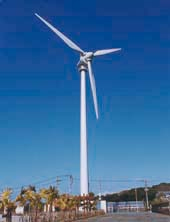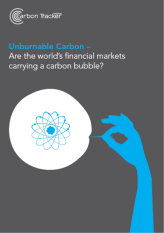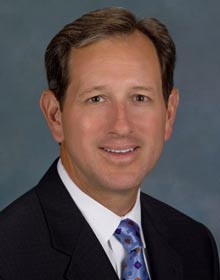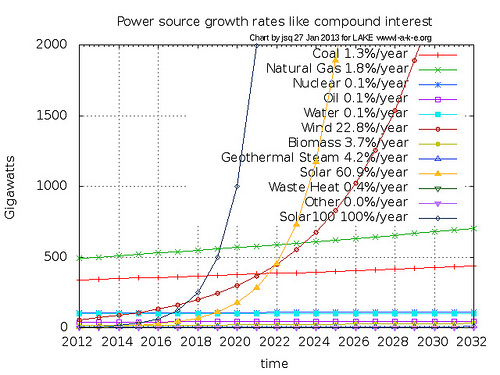What if instead of projecting percentages, we project gigawatts from FERC’s December 2012 Installed Operating Generating Capacity table? Solar and wind still win in less than a decade.
Ignore the fastest-growing curve for a moment; I added that. All the other curves start with the December 2012 gigawatts for each power source in the FERC table, and an annual compound growth rate computed by comparing that installed operating capacity to the capacity added in 2012 for that power source. That compound annual growth rate for solar is 60.9% and for wind is 22.8%. Nothing else comes close.
Solar passes coal in about 8 years, wind in about 9, and natural gas in
about
a decade.
That’s at the 60.9% rate, which is close to the
 65% rate observed for compound annual growth in solar deployments
for the past decade.
65% rate observed for compound annual growth in solar deployments
for the past decade.
What if we can push the solar growth rate faster, through some combination of Feed-In Tariffs, a carbon tax, rebates, or fully funding tax credits? And how about we fix that antiquated 1973 Georgia law that impedes private financing and investment for solar power in Georgia?
With some such combination, we could probably drive the solar compound growth rate up to 100% a year. That would make solar pass wind in 6 years, coal in 7, and natural gas in less than a year after that.
With either projection, solar and wind would provide most electricity in the U.S. in less than a decade. The faster the solar compound growth rate, the sooner that happens.
 And what if we also push up the wind compound annual growth rate?
Then it happens even faster.
Faster wind deployment would be pretty easy.
TEPCO already has
a wind turbine design that can withstand hurricanes
We could use that to
deploy wind off the Georgia coast.
And what if we also push up the wind compound annual growth rate?
Then it happens even faster.
Faster wind deployment would be pretty easy.
TEPCO already has
a wind turbine design that can withstand hurricanes
We could use that to
deploy wind off the Georgia coast.
Speaking of TEPCO, owner of the world’s worst nuclear disaster at Fukushima, nuclear remains down in the noise in this graph because its growth rate is less than a percent per year.
Now this graph shows deliberately naive projections to illustrate
the point of compound growth rates.
Obviously solar and wind growth rates have to slow at some point,
if only because eventually they can generate more energy than anybody
wants to use.
 But before that happens,
if solar and wind continue to grow at a compound rate for some years,
as solar
Moore’s Law for solar indicates solar can,
natural gas and coal will be used less, not more, because
new coal or natural gas generation will be priced out of the
market as
solar prices continue to drop
and
the carbon bubble pops.
So the time until solar and wind are the predominant sources
of electric power in the U.S. could be even shorter
than the graph indicates.
But before that happens,
if solar and wind continue to grow at a compound rate for some years,
as solar
Moore’s Law for solar indicates solar can,
natural gas and coal will be used less, not more, because
new coal or natural gas generation will be priced out of the
market as
solar prices continue to drop
and
the carbon bubble pops.
So the time until solar and wind are the predominant sources
of electric power in the U.S. could be even shorter
than the graph indicates.
Meanwhile,
even GE is apparently abandoning nuclear power.
It doesn’t matter how good a reactor GE designs if
 the concrete platform or containment breaks.
Nuclear power is good for
wars for uranium.
Solar power, not so much.
the concrete platform or containment breaks.
Nuclear power is good for
wars for uranium.
Solar power, not so much.
President Obama was not accurate when he said this in his second inaugural:
The path towards sustainable energy sources will be long and sometimes difficult.
If we stop pretending nuclear or natural gas or “clean coal” are sustainable energy sources, it doesn’t have to be long and it doesn’t have to be difficult. Especially if we do the next thing he said:
But America cannot resist this transition; we must lead it. We cannot cede to other nations the technology that will power new jobs and new industries—we must claim its promise. That is how we will maintain our economic vitality and our national treasure—our forests and waterways; our croplands and snowcapped peaks. That is how we will preserve our planet, commanded to our care by God. That’s what will lend meaning to the creed our fathers once declared.
We know how to generate jobs and energy independence for the U.S. and the world without wars for fuel or pipelines across countries. Solar and wind power are the way.
 This is what
the overwhelming majority of Americans want, according to a poll this month:
This is what
the overwhelming majority of Americans want, according to a poll this month:
86 percent of Americans want leadership on shifting from coal and nuclear energy to wind and solar. Support for this approach exists across party lines, including 72 percent of Republicans, 83 percent of Independents, and 97 percent of Democrats.
 You can
help Sierra Club send a message to Georgia Power CEO Paul Bowers:
You can
help Sierra Club send a message to Georgia Power CEO Paul Bowers:
we want to keep Georgia Jobs by investing in homegrown clean energy and energy efficiency to power our homes and businesses.
Let’s get on with it!
-jsq
Short Link:

Pingback: Arkansas tar sands oil spill | On the LAKE front